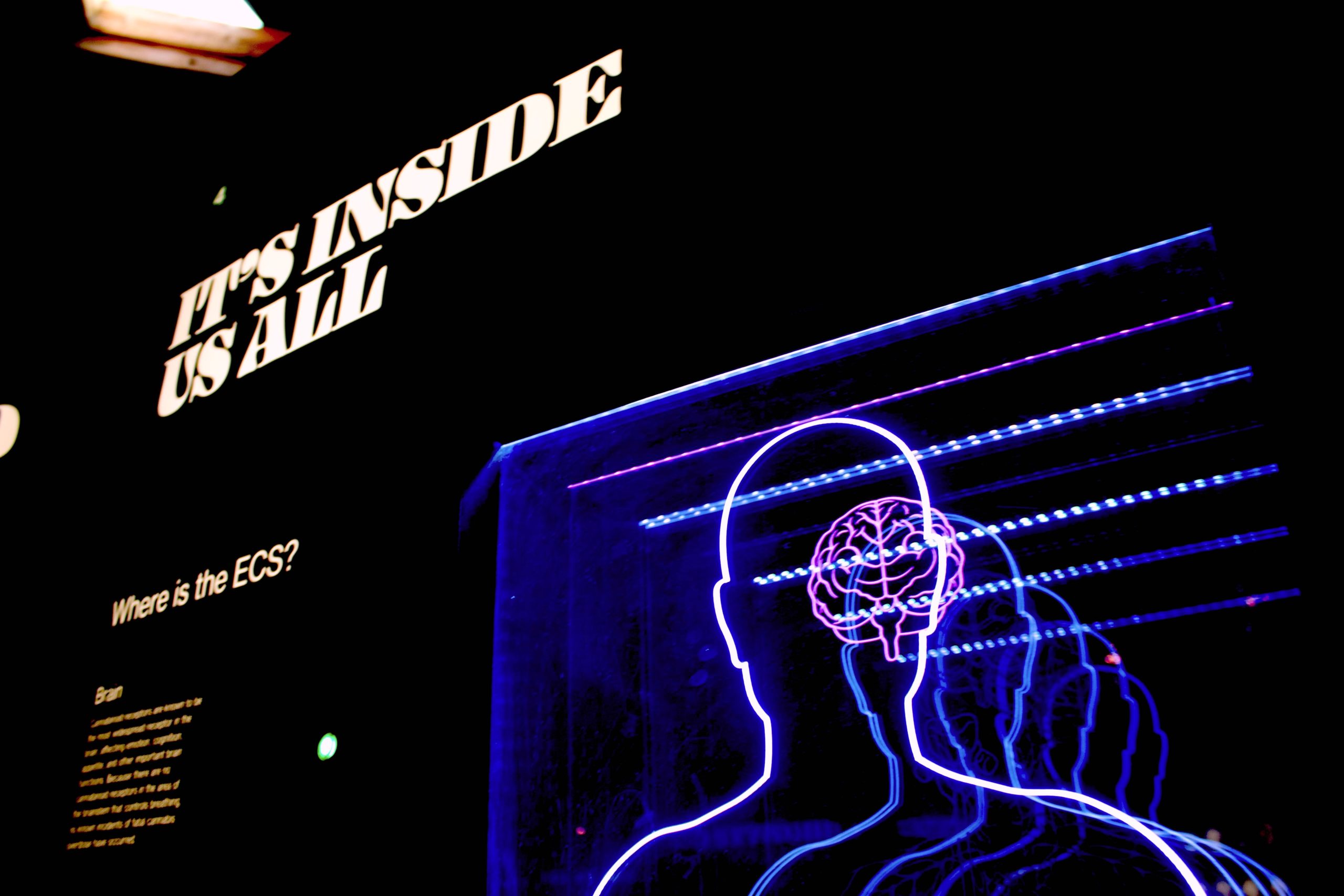
An exciting interdisciplinary research project by the VU called ‘harmonic dissonance’ is investigating the experience of ‘feeling on the same wavelength’ by people who communicate via sensory installations. Using hyperscanning, the researchers hope to get clarity on the question – What happens in our brains when we ‘connect’ with other humans?
An exciting interdisciplinary research project by the VU called ‘harmonic dissonance’ is investigating the experience of ‘feeling on the same wavelength’ by people who communicate via sensory installations. Using hyperscanning, the researchers hope to get clarity on the question – What happens in our brains when we ‘connect’ with other humans?

Photo by Bret Kavanaugh

Photo by Bret Kavanaugh
Researchers of Neuroscience have noticed that neural activity is different when we are interacting with other humans, in comparison to when we are alone (Czeszumski et al., 2020). During social interactions, two brains become coupled, or non-independent of each other. Think of a handshake: two hands don’t become one, but they become non-independent. The neuroimaging method hyperscanning records EEG, MEG or fMRI from two or more brains simultaneously, which allows for the investigation of intra- and inter-brain neural connections (Czeszumski et al., 2020).
When the VU showcased their project ‘harmonic dissonance’ in a 3-day workshop at Amsterdam’s nxt museum last February, my friend and I decided to check it out. At nxt museum, four large screens were installed on the walls. The screens were switched on as soon as you stood in front of them. Each screen translated our movements with different visual and audio forms, using different colors and instruments. Quickly, I noticed that my friend’s movements captured from her screen were mingling with my movements on my screen, and vice versa. We were able to communicate with music and visuals – without even facing each other. The aim of this project is to investigate if the interaction via the sensory installations – by friends, couples or even strangers – could lead to a feeling of closeness. My friend and I agreed that we indeed felt closer after interacting through the installations for about five minutes.
The researchers at the nxt museum also used EEG on visitors and professional dancers which were hired to showcase their beautiful sensory installations. This is where hyperscanning came in: Using hyperscanning, they were able to measure the neural effects of ‘feeling on the same wavelength’ of those interacting via the installations.
“Hyperscanning is used to investigate the emotional component of social interactions, the mirror neuron system, and more.”
The first hyperscanning study ever conducted used fMRI (Montage, 2002), but due to the loud cylinder, the immobility of fMRI and the slow temporal signal of fMRI, EEG has been a more popular choice in recent years (Czeszumski et al., 2020). EEG, with its high temporal resolution, allows for the coupling of two people, and its mobility allows social interaction to happen in the lab – or even at the nxt museum.
Since its first application in 2002, hyperscanning has been used to investigate a wide range of fascinating interhuman phenomena. For example, it was shown that certain osscillations are associated with higher kissing satisfaction in heterosexual couples (Müller & Lindenberger, 2014). Music has also been a big research area for hyperscanning. Aquardro et al. (2016), for example, have used hyperscanning on two people who played the guitar together. Furthermore, hyperscanning is used to investigate the emotional component of social interactions, the mirror neuron system, and more.
In sum, hyperscanning seems to promise a vast amount of novel insights on the neural networks of social interaction, uncovering the mechanisms of the communication that makes up human connection, and entire social dynamics. <<
References
– Acquadro, M. A. S., Congedo, M., & De Riddeer, D. (2016). Music Performance As an Experimental Approach to Hyperscanning Studies. Frontiers in Human Neuroscience, 10.
– Czeszumski, A., Eustergerling, S., Lang, A., Menrath, D., Gerstenberger, M., Schuberth, S., Schreiber, F., Rendon, Z. Z., & König, P. (2020). Hyperscanning: A Valid Method to Study Neural Inter-brain Underpinnings of Social Interaction. Frontiers in Human Neuroscience, 14.
– Montague, P. (2002). Hyperscanning: Simultaneous fMRI during Linked Social Interactions. NeuroImage, 16(4), 1159–1164.
– Müller, V., & Lindenberger, U. (2014). Hyper-Brain Networks Support Romantic Kissing in Humans. PLoS ONE, 9(11), e112080.
Researchers of Neuroscience have noticed that neural activity is different when we are interacting with other humans, in comparison to when we are alone (Czeszumski et al., 2020). During social interactions, two brains become coupled, or non-independent of each other. Think of a handshake: two hands don’t become one, but they become non-independent. The neuroimaging method hyperscanning records EEG, MEG or fMRI from two or more brains simultaneously, which allows for the investigation of intra- and inter-brain neural connections (Czeszumski et al., 2020).
When the VU showcased their project ‘harmonic dissonance’ in a 3-day workshop at Amsterdam’s nxt museum last February, my friend and I decided to check it out. At nxt museum, four large screens were installed on the walls. The screens were switched on as soon as you stood in front of them. Each screen translated our movements with different visual and audio forms, using different colors and instruments. Quickly, I noticed that my friend’s movements captured from her screen were mingling with my movements on my screen, and vice versa. We were able to communicate with music and visuals – without even facing each other. The aim of this project is to investigate if the interaction via the sensory installations – by friends, couples or even strangers – could lead to a feeling of closeness. My friend and I agreed that we indeed felt closer after interacting through the installations for about five minutes.
The researchers at the nxt museum also used EEG on visitors and professional dancers which were hired to showcase their beautiful sensory installations. This is where hyperscanning came in: Using hyperscanning, they were able to measure the neural effects of ‘feeling on the same wavelength’ of those interacting via the installations.
“Hyperscanning is used to investigate the emotional component of social interactions, the mirror neuron system, and more.”
The first hyperscanning study ever conducted used fMRI (Montage, 2002), but due to the loud cylinder, the immobility of fMRI and the slow temporal signal of fMRI, EEG has been a more popular choice in recent years (Czeszumski et al., 2020). EEG, with its high temporal resolution, allows for the coupling of two people, and its mobility allows social interaction to happen in the lab – or even at the nxt museum.
Since its first application in 2002, hyperscanning has been used to investigate a wide range of fascinating interhuman phenomena. For example, it was shown that certain osscillations are associated with higher kissing satisfaction in heterosexual couples (Müller & Lindenberger, 2014). Music has also been a big research area for hyperscanning. Aquardro et al. (2016), for example, have used hyperscanning on two people who played the guitar together. Furthermore, hyperscanning is used to investigate the emotional component of social interactions, the mirror neuron system, and more.
In sum, hyperscanning seems to promise a vast amount of novel insights on the neural networks of social interaction, uncovering the mechanisms of the communication that makes up human connection, and entire social dynamics. <<



